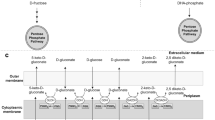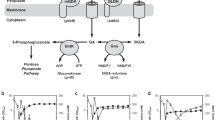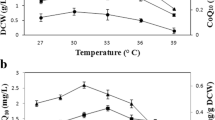Abstract
The physiological characteristics and the potential gluconolactone production of the gluconolactonase-deficient strain, Zymomonas mobilis ZM4 gnlΔ, were investigated via growth inhibitory assay and biotransformation of glucose and fructose into gluconolactone and sorbitol, respectively. The results of ethanol fermentation studies performed in the presence of high concentration of glucose (>200 g l−1) under fermentative or aerobic conditions indicated that a significant reduction of volumetric ethanol productivity from the strain of ZM4 gnlΔ was noticeable due to the reduced rates of specific growth, sugar uptake, and biomass yield as compared with those of the parental strain ZM4. The biotransformation prepared at pH 6.0 using the permeabilized cell indicated that gluconic acid from ZM4 gnlΔ was still produced as a major product (67 g l−1) together with sorbitol (65 g l−1) rather than gluconolactone after 24 h. Only small amount of gluconolactone was transiently overproduced up to 9 g l−1, but at the end of biotransformation, all gluconolactone were oxidized into gluconic acid. This indicated that autolysis of gluconolactone at the pH led to such results despite under gluconolactonase inactivation conditions. The physiological characteristics of ZM4 gnlΔ was further investigated under various stress conditions, including suboptimal pH (3.5~6.0), temperature (25~40 °C), and presence of growth inhibitory molecules including hydrogen peroxide, ethanol, acetic acid, furfural, and so forth. The results indicated that ZM4 gnlΔ was more susceptible at high glucose concentration, low pH of 3.5, and high temperature of 40 °C and in the presence of 4 mM H2O2 comparing with ZM4. Therefore, the results were evident that gluconolactonase in Z. mobilis contributed to industrial robustness and anti-stress regulation.



Similar content being viewed by others
References
Balodite E, Strazdina I, Galinina N, McLean S, Rutkis R, Poole RK, Kalnenieks U (2014) Structure of the Zymomonas mobilis respiratory chain: oxygen affinity of electron transport and the role of cytochrome c peroxidase. Microbiology 160(9):2045–2052
Chun U, Rogers P (1988) The simultaneous production of sorbitol from fructose and gluconic acid from glucose using an oxidoreductase of Zymomonas mobilis. Appl Microbiol Biotechnol 29(1):19–24
Erzinger GS, Vitolo M (2006) Zymomonas mobilis as catalyst for the biotechnological production of sorbitol and gluconic acid. Appl Biochem Biotechnol 131(1–3):787–794
Furusawa H, Sato Y, Tanaka Y, Inai Y, Amano A, Iwama M, Kondo Y, Handa S, Murata A, Nishikimi M, Goto S, Maruyama N, Takahashi R, Ishigami A (2008) Vitamin C is not essential for carnitine biosynthesis in vivo: verification in vitamin C-depleted senescence marker protein-30/gluconolactonase knockout mice. Biol Pharm Bull 31(9):1673–1679
Goodman AE, Rogers PL, Skotnicki ML (1982) Minimal medium for isolation of auxotrophic Zymomonas mutants. Appl Environ Microbiol 44(2):496
Hasegawa G, Yamasaki M, Kadono M, Tanaka M, Asano M, Senmaru T, Kondo Y, Fukui M, Obayashi H, Maruyama N, Nakamura N, Ishigami A (2010) Senescence marker protein-30/gluconolactonase deletion worsens glucose tolerance through impairment of acute insulin secretion. Endocrinology 151(2):529–536
He MX, Wu B, Qin H, Ruan ZY, Tan FR, Wang JL, Shui ZX, Dai LC, Zhu QL, Pan K (2014) Zymomonas mobilis: a novel platform for future biorefineries. Biotechnol Biofuels 7(1):1
Hucho F, Wallenfels K (1972) Glucono-δ-lactonase from Escherichia coli. Biochim Biophys Acta Enzymol 276(1):176–179
Invitrogen (2007) BL21(DE3)pLysS Cells. Publisher. https://catalog.invitrogen.com/index.cfm?fuseaction=viewCatalog.viewProductDetails&productDescription=597
Jeon YJ, Svenson CJ, Joachimsthal EL, Rogers PL (2002) Kinetic analysis of ethanol production by an acetate-resistant strain of recombinant Zymomonas mobilis. Biotechnol Lett 24(10):819–824
Joachimsthal E, Haggett KD, Jang J-H, Rogers PL (1998) A mutant of Zymomonas mobilis ZM4 capable of ethanol production from glucose in the presence of high acetate concentrations. Biotechnol Lett 20(2):137–142
Kanagasundaram V, Scopes R (1992) Isolation and characterization of the gene encoding gluconolactonase from Zymomonas mobilis. Biochim Biophys Acta 1171(2):198–200
Kerr AL, Jeon YJ, Svenson CJ, Rogers PL, Neilan BA (2011) DNA restriction-modification systems in the ethanologen, Zymomonas mobilis ZM4. Appl Microbiol Biotechnol 89(3):761–769
Kim IS, Barrow KD, Rogers PL (2000) Kinetic and nuclear magnetic resonance studies of xylose metabolism by recombinant Zymomonas mobilis ZM4(pZB5). Appl Environ Microbiol 66(1):186–193
King FG, Hossain MA (1982) The effect of temperature, pH, and initial glucose concentration on the kinetics of ethanol production by Zymomonas mobilis in batch fermentation. Biotechnol Lett 4(8):531–536
Kondo Y, Inai Y, Sato Y, Handa S, Kubo S, Shimokado K, Goto S, Nishikimi M, Maruyama N, Ishigami A (2006) Senescence marker protein 30 functions as gluconolactonase in L-ascorbic acid biosynthesis, and its knockout mice are prone to scurvy. Pro Natl Acad Sci 103(15):5723–5728
Luria SE, Delbruck M (1943) Mutation of bacteria from virus sensitivity to virus resistance. Genetics 28:491–511
Ma K, Ruan Z, Shui Z, Wang Y, Hu G, He M (2016) Open fermentative production of fuel ethanol from food waste by an acid-tolerant mutant strain of Zymomonas mobilis. Bioresour Technol 203:295–302
Neilan BA, Jacobs D, Del Dot T, Blackall LL, Hawkins PR, Cox PT, Goodman AE (1997) rRNA sequences and evolutionary relationships among toxic and nontoxic cyanobacteria of the genus Microcystis. Int J Syst Bacteriol 47(3):693–697
Nidetzky B, Furlinger M, Gollhofer D, Haug I, Haltrich D, Kulbe KD (1997) Simultaneous enzymatic synthesis of gluconic acid and sorbitol: production, purification, and application of glucose-fructose oxidoreductase and gluconolactonase. Appl Biochem Biotechnol 63-65:173–188
Parke SA, Birch GG, MacDougall DB, Stevens DA (1997) Tastes, structure and solution properties of D-glucono-1, 5-lactone. Chem Senses 22(1):53–65
Promega (2007) Technical Manual: pGEM®-T and pGEM®-T Easy Vector Systems. Publisher. http://www.promega.com/tbs/tm042/tm042.pdf
Rogers P, Lee KJ, Tribe D (1979) Kinetics of alcohol production by Zymomonas mobilis at high sugar concentrations. Biotechnol Lett 1(4):165–170
Rogers PL, Lee JS, Skotnicki ML, Tribe DE (1982) Ethanol production by Zymomonas mobilis. Adv Biochem Eng 23:37–84
Rogers P, Jeon Y, Lee K, Lawford H (2007) Zymomonas mobilis for fuel ethanol and higher value products biofuels. Adv Biochem Eng Biotechnol 108:263–288
Sambrook J, Fritsch EF, Maniatis T (1989) Molecular cloning, vol 2. Cold Spring Harbor Laboratory Press, New York
Sato Y, Amano A, Kishimoto Y, Takahashi K, Handa S, Maruyama N, Ishigami A (2014) Ascorbic acid prevents protein oxidation in livers of senescence marker protein-30/gluconolactonase knockout mice. Geriatr Gerontol Int 14(4):989–995
Senmaru T, Yamazaki M, Okada H, Asano M, Fukui M, Nakamura N, Obayashi H, Kondo Y, Maruyama N, Ishigami A, Hasegawa G (2012) Pancreatic insulin release in vitamin C-deficient senescence marker protein-30/gluconolactonase knockout mice. J Clin Biochem Nutr 50(2):114–118
Seo JS, Chong H, Park HS, Yoon KO, Jung C, Kim JJ, Hong JH, Kim H, Kim JH, Kil JI (2005) The genome sequence of the ethanologenic bacterium Zymomonas mobilis ZM4. Nat Biotechnol 23(1):63–68
Shvinka JE, Pankova LM, Mežbårde IN, Licis LJ (1989) Hydrogen peroxide production by Zymomonas mobilis. Appl Microbiol Biotechnol 31(3):240–245
Silveira M, Jonas R (2002) The biotechnological production of sorbitol. Appl Microbiol Biotechnol 59(4–5):400–408
Strazdina I, Kravale Z, Galinina N, Rutkis R, Poole RK, Kalnenieks U (2012) Electron transport and oxidative stress in Zymomonas mobilis respiratory mutants. Arch Microbiol 194(6):461–471
Wilson K (1987) Preparation of genomic DNA from bacteria. Curr Protoc Mol Biol 2.4. 1–2.4. 5
Yang WB, Patil SS, Tsai CH, Lin CH, Fang JM (2002) The synthesis of L-gulose and L-xylose from δ-gluconolactone. Tetrahedron 58(2):253–259
Yang S, Tschaplinski TJ, Engle NL, Carroll SL, Martin SL, Davison BH, Palumbo AV, Rodriguez M, Brown SD (2009) Transcriptomic and metabolomic profiling of Zymomonas mobilis during aerobic and anaerobic fermentations. BMC Genomics 10(1):1–16
Yang S, Fei Q, Zhang Y, Contreras LM, Utturkar SM, Brown SD, Himmel ME, Zhang M (2016) Zymomonas mobilis as a model system for production of biofuels and biochemicals. Microb Biotechnol 9(6):699–717
Author information
Authors and Affiliations
Corresponding author
Ethics declarations
Funding
This research as carried out with support of the National Research Foundation of Korea (NRF) under Grant No. NRF-2015R1D1A1A01056794.
Conflict of interest
The authors declare that they have no conflict of interest.
Ethical approval
This article does not contain any studies with human participants or animals performed by any of the authors.
Rights and permissions
About this article
Cite this article
Alvin, A., Kim, J., Jeong, GT. et al. Industrial robustness linked to the gluconolactonase from Zymomonas mobilis . Appl Microbiol Biotechnol 101, 5089–5099 (2017). https://doi.org/10.1007/s00253-017-8248-y
Received:
Revised:
Accepted:
Published:
Issue Date:
DOI: https://doi.org/10.1007/s00253-017-8248-y




